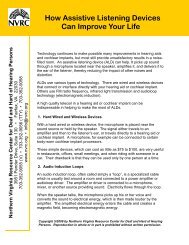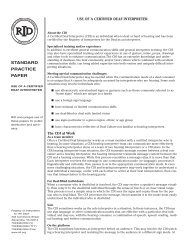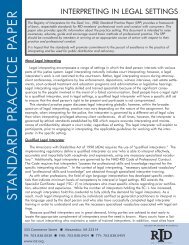Video Remote Interpreting Standard Practice Paper - Registry of ...
Video Remote Interpreting Standard Practice Paper - Registry of ...
Video Remote Interpreting Standard Practice Paper - Registry of ...
You also want an ePaper? Increase the reach of your titles
YUMPU automatically turns print PDFs into web optimized ePapers that Google loves.
STANDARD PRACTICE PAPER<br />
Readiness Protocol<br />
VRI sessions require explicit content, technical and environmental preparation by those involved.<br />
Interpreters and participants should be educated in VRI protocols and equipment. <strong>Video</strong>conferencing<br />
protocol training is widely available and encouraged. 2 Additionally, those participating in VRI sessions<br />
should obtain as much training and education about their respective video and audio equipment as<br />
possible via onsite or remote instruction, or self-paced learning.<br />
As with onsite interpreting, VRI interpreting requires preparation by the interpreter to maintain quality<br />
standards. Preparation is needed for both appointment-based and on-demand services. The amount<br />
and type <strong>of</strong> preparation is dependent on the nature <strong>of</strong> the assignment and the interpreter’s pre-existing<br />
knowledge base. To prepare for a VRI session, meeting organizers and participants analyze for appropriateness<br />
<strong>of</strong> VRI, as well as environmental and technical preparations as discussed in sections below.<br />
Content<br />
VRI sessions are successful when participants and interpreters have a shared knowledge <strong>of</strong> session<br />
content. Familiarity with topic and content leads to effective communication. Prior to a VRI session, relevant<br />
personnel share content information with the interpreter(s) through teleconference sessions, e-mail<br />
correspondence, faxed information or other means. Interpreter access to VRI session topic and content is<br />
advantageous for both appointment-based and on-demand VRI services.<br />
Technical<br />
VRI uses videoconferencing equipment over high-speed broadband connections or ISDN lines carrying<br />
both video and audio messages. Equipment is paired with wired or wireless connections. VRI sessions<br />
can be conducted via Internet, Intranet or ISDN. As technology evolves, additional connection<br />
types may become available.<br />
In terms <strong>of</strong> equipment, there are two kinds <strong>of</strong> VRI providers: those that recommend or endorse certain<br />
kinds <strong>of</strong> equipment that can be purchased and used by the receiving institutions and those that<br />
configure and sell a specific equipment package to be used by the receiving institution. Additional technical<br />
information is cited in the References Section <strong>of</strong> this paper.<br />
Due to its videoconferencing nature, VRI sessions require technical familiarization by those involved.<br />
An extensive collaboration from the receiving institution’s information technology department or videoconferencing<br />
department must be established and onsite technical support staff must be identified.<br />
Sufficient lead-time is required to arrange the many technical aspects and logistics involved in VRI<br />
services. Equipment must be tested allowing ample time to ensure that the connection provides for clear<br />
reception at all sites. Prior to troubleshooting equipment, participants should understand equipment and<br />
connection type. Many entities using VRI have access to technical personnel for initial set-up and working<br />
sessions. Generally, technical support is available from the VRI provider and tends to be located <strong>of</strong>fsite.<br />
Prior to and during VRI sessions, an individual with a current knowledge <strong>of</strong> video and audio connections,<br />
IP settings, hardware arrangements and s<strong>of</strong>tware configurations should be immediately available.<br />
Session testing provides quality assurance for bandwidth, video and audio clarity and maintenance <strong>of</strong><br />
connection. Interpreters and participants may need to troubleshoot technical issues before and during<br />
an interpreted session.<br />
Environmental Controls<br />
Environments suitable for traditional onsite interpreting may not be appropriate for VRI. Effective<br />
management <strong>of</strong> environmental demands by all parties will help facilitate an acceptable provision <strong>of</strong><br />
interpreting services. Environmental demands that may affect the VRI session include:<br />
• lighting<br />
• seating arrangements or sight lines to each video screen<br />
2 <strong>Video</strong> Development Initiative, 2005<br />
2 <strong>Video</strong> <strong>Remote</strong> <strong>Interpreting</strong> - General






